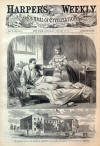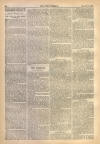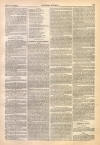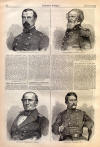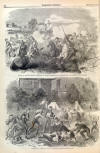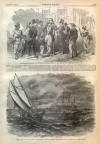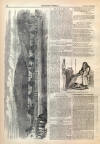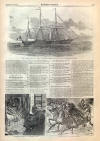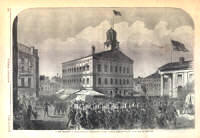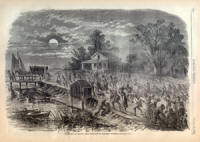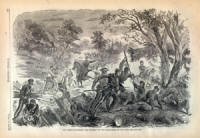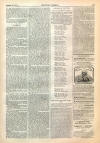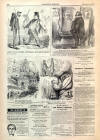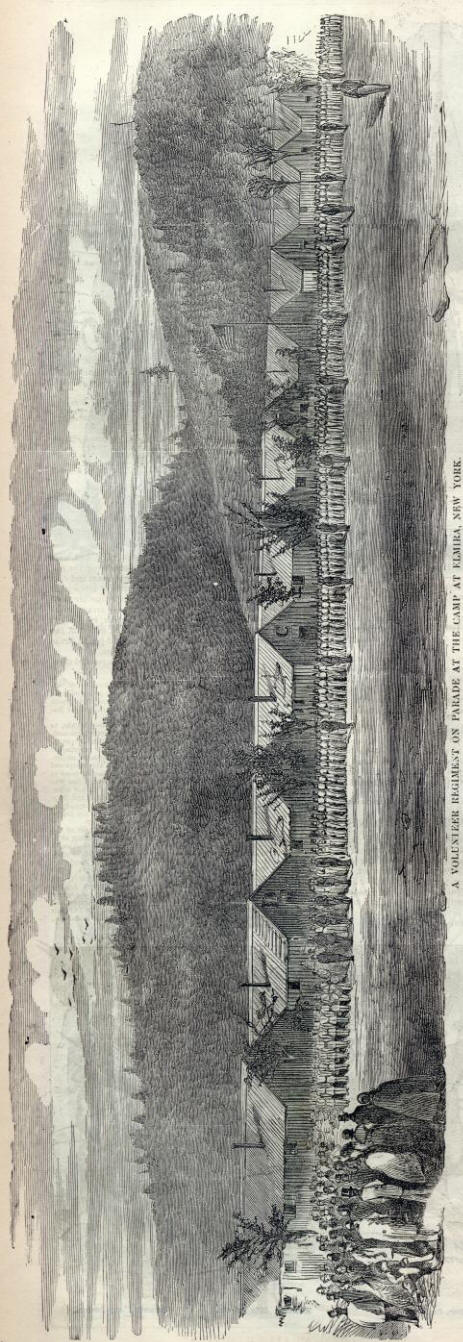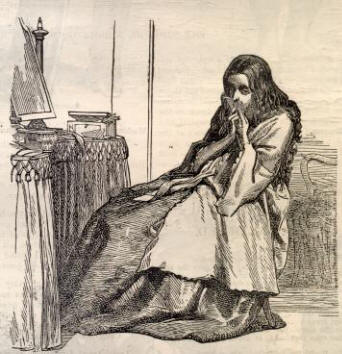|
This Site:
Civil War
Civil War Overview
Civil War 1861
Civil War 1862
Civil War 1863
Civil War 1864
Civil War 1865
Civil War Battles
Confederate Generals
Union Generals
Confederate History
Robert E. Lee
Civil War Medicine
Lincoln Assassination
Slavery
Site Search
Civil War Links
Civil War Art
Revolutionary War
Mexican War
Republic of Texas
Indians
Winslow Homer
Thomas Nast
Mathew Brady
Western Art
Civil War Gifts
Robert E. Lee Portrait
|
THE WAR IN MISSOURI.
ON page 518 we illustrate the RESCUE OF COLONEL SMITH'S COMMAND from an
overwhelming rebel attack by a force of Union cavalry under Governor Wood, of
Illinois. Colonel Smith's command occupied the brick college building at Monroe,
and the rebels, 1200 strong, had surrounded it and planted cannon so as to
destroy the building and its inmates. A flag of truce had been sent out, but it
was disregarded. Three hundred mounted men were at once sent to the rescue. On
arriving at Monroe they formed a junction with Colonel Smith's force, who had intrenched themselves in the academy buildings. The rebels, 1200 strong, were
grouped around over the prairies, out of the reach of Colonel Smith's rifles.
They had two pieces of artillery, which were brought to bear, but the distance
was so great that their balls were almost spent before they reached our lines.
Colonel Smith's artillery, of longer range, did considerable execution. The
fight lasted until dusk. The last shot from Colonel Smith's guns dismounted one
of the enemy's. Just at that moment Governor Wood, of Illinois, fell on their
rear with the cavalry sent from Quincy on Wednesday, completely routing them,
and taking seventy-five prisoners, one gun, and a large number of horses. Twenty
or thirty of the enemy were killed ; but not a man of the Union forces was
killed, although several were severely wounded.
RECAPTURE OF THE SCHOONER
"ENCHANTRESS."
WE give on page 519 an illustration of the RECAPTURE OF THE SCHOONER
"ENCHANTRESS" BY THE GUN-BOAT " ALBATROSS," from a sketch by Mr. Donovan, of the
latter craft. A letter in the Tribune thus describes the affair:
On Sunday, the 19th, after sailing two or three hours southward
and eastward, the Albatross sighted a vessel and gave chase, and soon fetched up
to what proved to be the Enchantress, captured by the privateer Jeff Davis, six
days out from Boston to St. Jago, and in possession of a prize crew of five
rebels and a negro belonging to the schooner before she was taken. On speaking
her and demanding where from and whence bound, she replied, "Boston for St. Jago."
At this moment the negro rushed from the galley where the
pirates had secreted him and jumped into the sea, exclaiming. "They are a
privateer crew from the .Jeff Davis, and bound for
Charleston." The negro was
picked up and taken on the Albatross. The prize was ordered to heave to, which
she did. Lieut. Neville jumped aboard of her, and ordered the
pirates into the
boats, and to pull for the Albatross, where they were secured in irons. Two of
the prisoners are Charleston pilots, one is from Boston, and two from
Brooklyn—one of the latter has a brother in Fortress Monroe, and the other has a
brother on the Roanoke. Prize-master Tunis D. Wendell was
ordered on board the schooner, which was taken in tow by the
Albatross, and arrived in Hampton Roads on Wednesday, the. 22d. The Albatross
will shortly proceed to Philadelphia or New York for repairs to her machinery.
The vessel has now a reputation which is a terror to the rebels, on sea and
coast, as a fighting craft which they had better give a wide berth to.
AFTER THE BATTLE.
OUR special artist in
Washington has supplied us with the sketches which we
reproduce on pages 513 and
519. One represents a
WOUNDED ZOUAVE in the hospital
at Washington looking gratefully up at the face of his kind hospital nurse. The
poor fellow is evidently not used to the tender attention bestowed upon him by
the lady volunteer; he does not quite understand it, and some secret well of
honest, grateful feeling seems to have been suddenly opened in his heart.
Another picture introduces us to the same character, the typical Zouave,
relating his adventures at the
Battle of Bull Run to a crowd of eager listeners
on Pennsylvania Avenue. He is in his hour of triumph, and well he may be. He
feels a quiet contempt for the men of his own age who were not at the battle ;
for he knows that henceforth no lady fair will smile on them so long as he or
any of his comrades who were " in the battle" are near by.
THE
REBEL FLAG AT HARPER'S
FERRY.
ENCAMPMENT OF THE NINTH REGIMENT, N. Y. S. M., SANDY HOOK, MD., July 30, 1861.
To the Editor of Harper's Weekly:
HAVING noticed in your paper of August 3 a sketch representing
two members of the Ninth tearing down the
rebel flag at Harper's Ferry on the
morning of the 4th, and deeming it but justly due to the person who performed
the feat, I take the liberty of making this correction.
On the morning of the 4th about a dozen of the members of this
regiment crossed the river to
Harper's Ferry in a small boat, and strolled
around the town. Seeing the rebel flag floating from the flag-staff, a member of
Company C of this regiment, Edwin W. Butler by name, succeeded in climbing up to
it and tearing it down. The persons mentioned in your paper (Isaac Blakemore and
George M'Mullin) are not members of this regiment, nor were they present at the
time the occurrence took place.
A portion of the State flag, which you mention, still remains,
and was flying over the "stars and bars," which latter Butler succeeded in
taking down. The
stars and stripes proudly floats from the pole at present,
directly under the State flag, nobody having displaced it. I take the
liberty of inclosing you a small piece obtained from the.
"original Jacobs," who is one of my messmates. Hoping you will give this an
early insertion, and give honor to whom honor is due, I am, dear Sir,
Respectfully yours,
ISAAC S. SHARPE,
Co. C, Ninth Regt., N. Y. S. M.,
An eye-witness.
It seems that there must have been two
rebel flags hauled clown at Harper's
Ferry, one by Blakemore and M'Mullin, the other by Butler of the New York Ninth.
Our picture represented the former scene.—ED. Harper's Weekly.
OUR SECRET DRAWER.
THERE is a secret drawer in every heart,
Wherein we lay our treasures one by one; Each dear remembrance of the buried
past;
Each cherished relic of the time that's gone;
The old delights of childhood long ago;
The things we loved, because we knew them best; The first discovered primrose in
our path ; The cuckoo's earliest note; the robin's nest;
The merry hay-makings around our home;
Our rambles in the summer woods and lanes; The story told beside the winter
fire,
While the wind moaned across the window panes;
The golden dreams we dreamt in after-years; Those magic visions of our young
romance; The sunny nooks, the fountains and the flowers, Gilding the fairy
landscape of our trance; The link which bound us later still to one Who fills a
corner in our life to-day,
Without whose love we dare not dream how dark The rest would seem, if it were
gone away; The song that thrill'd our souls with very joy; The gentle word that
unexpected came;
The gift we prized, because the thought was kind; The thousand, thousand things
that have no name. All these in some far hidden corner lie, Within the mystery
of that secret drawer,
Whose magic springs, though stranger hands may touch, Yet none may gaze upon its
guarded store.
BAYONETING OUR WOUNDED.
ON page 525 we illustrate a most disgraceful episode of the Battle of Bull Run,
which would be incredible if it were not attested by so many reliable witnesses:
we mean the BAYONETING OF OUR WOUNDED BY THE REBEL TROOPS. The following
evidence of Surgeon Barnes, given to the reporter of the New York Tribune, is
unfortunately too precise and clear to be questioned :
Surgeon Barnes, of the New York Twenty-eighth Volunteers, was in
the fight all through, and came out of it in his shirt sleeves, having lost
coat, sash, watch, and all his surgical instruments, having been charged on by
the
Black Horse Cavalry and compelled to leave the field, being driven from
under a tree where he had established his temporary quarters, and where he was
attending to the wounds of about twenty-five injured men, part of whom were
secessionists.
Surgeon Barnes went up to the battle-field in the rear of the
attacking column, and, as soon as our men began to fall, he took a position with
his assistants under a tree, in a little ravine. The wounded men were brought to
him, and he took off his green sash and hung it on the tree to signify that the
place was under the Charge of a surgeon. The injured men were brought in
rapidly, and in fifteen minutes he had under his charge nearly thirty. As fast
as possible he attended to their hurts, and in a short time had been compelled
to perform a number of capital operations. He amputated four legs, three arms, a
hand, and a foot, and attended to a number of minor injuries. By this time the
enemy had discovered the place, and the nature of the men in charge, and began
to pour in musket-balls, and projectiles from rifled cannon. The place became
unsafe for the wounded men, and it was seen to be necessary to remove them. The
Surgeon's Assistants and servant had become separated from him, and he had no
one to send for ambulances, and was obliged to leave the wounded men and go
himself. It was no easy matter to procure ambulances enough, and it was probably
thirty minutes before the Surgeon returned with the necessary assistance. When
he returned he found that every one of those wounded men had been bayoneted or
sabred, and was dead. They were literally cut to pieces.
Other evidence abounds. An officer of the Massachusetts 5th, lying wounded on
the field, heard the order given by a rebel officer to "bayonet the sons of—of
red shirts!" Cannon were trained on the soldiers who were bearing of the field
the, body of
Colonel Cameron, and five were killed.. The ambulance in which
Colonel Wood (New York 14th) was being carried was repeatedly fired at. (Next
Page)
"THERE IS A SECRET DRAWER IN EVERY HEART—"
|
